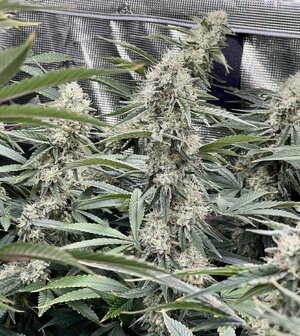Observer
Quantum Yield Engineer
- Joined
- May 11, 2023
- Messages
- 7,903
- Reaction score
- 19,388
ok sorry im unloading research now
you got me back in it
you got me back in it
1. Heat Stress and Enzyme Activity
Temperature Effects on Enzymes:- Enzyme Denaturation: High temperatures can cause denaturation of enzymes involved in various metabolic processes. Enzymes such as those responsible for protein synthesis, hormone regulation, and secondary metabolite production may lose their functional shape and efficiency, disrupting normal plant growth and development.
- Reduced Enzyme Activity: Elevated temperatures can reduce the activity of critical enzymes like ribulose-1,5-bisphosphate carboxylase/oxygenase (RuBisCO), which is essential for photosynthesis. This can lead to reduced photosynthetic rates and energy production, affecting overall plant health and growth.
2. Hormonal Imbalances
Auxins and Gibberellins:- Auxins: These are plant hormones that regulate cell elongation and differentiation. Heat stress can alter auxin distribution and signaling, leading to abnormal growth patterns and foxtailing.
- Gibberellins: These hormones promote cell elongation and bud development. High temperatures can cause an imbalance in gibberellin levels, leading to excessive elongation of the internodes and abnormal bud formation.
3. Photosynthesis and Respiratory Changes
Photosynthetic Efficiency:- Photosynthetic Rate: High temperatures can decrease the efficiency of the photosynthetic process, reducing the production of carbohydrates and other essential compounds needed for healthy bud development.
- Respiration Increase: Heat stress can increase the rate of respiration, leading to higher energy consumption and reduced availability of energy for growth and development.
4. Heat Shock Proteins
Role of Heat Shock Proteins:- Protein Production: In response to high temperatures, plants produce heat shock proteins (HSPs) to protect other proteins from damage. HSPs assist in refolding denatured proteins and help maintain cellular function under stress.
- Stress Response: The production of HSPs is a protective response that can alter normal growth patterns and development, potentially leading to abnormal bud and calyx formation.
5. Thermal Regulation and Plant Structure
Stomatal Closure:- Water Loss: High temperatures can cause the stomata (tiny openings on leaves) to close to reduce water loss. This can limit gas exchange, affecting CO2 availability and photosynthesis.
- Heat Stress Impact: Stomatal closure can exacerbate heat stress by limiting the plant’s ability to cool itself and regulate internal temperatures.
- Cell Membrane Integrity: Heat stress can disrupt the integrity of cellular membranes, causing leakage of cellular contents and affecting cell function. This can lead to abnormal growth patterns and structural changes in buds and flowers.
6. Reproductive Response
Calyx Stacking:- Stress Response: In response to heat stress, plants may increase the density of calyxes as a defensive mechanism. This can be a way to protect the reproductive parts and ensure successful pollination despite adverse conditions.
- Altered Flowering Patterns: High temperatures can alter the flowering cycle, leading to changes in the development and arrangement of calyxes.
7. Gene Expression
Heat Stress Genes:- Heat-Responsive Genes: High temperatures trigger the expression of heat-responsive genes that are involved in stress responses and adaptation. These genes can influence various physiological processes, including growth, development, and reproductive structures.
- Transcription Factors: Heat stress can affect the activity of transcription factors that regulate gene expression, leading to changes in growth patterns and reproductive structures.





























